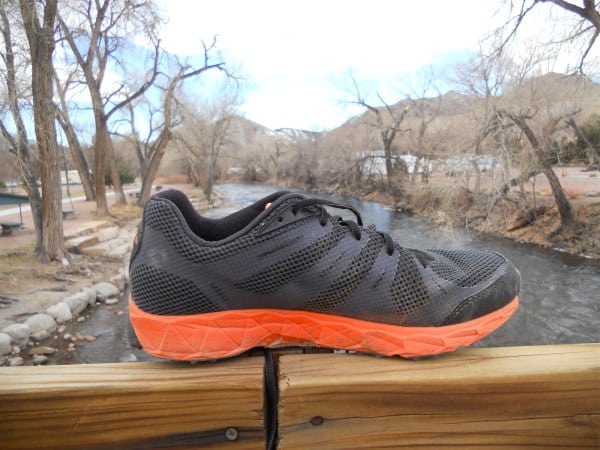Our Favorite Trail Running Shoes
Check out our Best Trail Running Shoes article to learn about our current favorite trail running shoes!
Montrail Badwater Review
For most of us, the idea of a hybrid shoe makes sense. We may run on roads to get to the trailhead or link up several trails with road sections. Many trail races feature sections of road, doubletrack, or asphalt that while mentally less stimulating, provide time to drop the pace and stretch out the legs. It is always disconcerting when a trail shoe feels bulky, stiff, or otherwise awkward when you hit the road.
But, the purist in me wants to separate the two – road and trail – for no real reason. So, I’m skeptical to think that a shoe could perform and protect on technical trail and still feel smooth on the roads. But with many ultras having significant road portions/non-technical portions (Leadville, UROC, Western States, and American River) having a shoe built to tackle everything makes perfect sense.
Montrail gives us the new Badwater which weighs in at 9.7 oz with 10mm of heel drop. It is built on the same platform as the Fairhaven, Montrail’s other hybrid shoe. The main difference between the two is the weight (the Fairhaven is 11 oz.), the Badwater’s lack of Montrail’s fluid post, and the much improved upper. While its namesake suggests more of a road-oriented shoe, I found it trail worthy, as well.
Upper
Montrail uses welded overlays removing most of the stitching present on their shoes, including the Badwater, to create an abrasion-free upper. Running my hand around the inside of the upper proves that it is seamless and I had zero issues with rubbing. A breathable, dual-density mesh underscores these well-placed overlays, creating a foot-hugging fit throughout the upper. The lacing system is incorporated into the overlays and is otherwise fairly traditional with oval laces that stay tied. An effective toe bumper made of durable, reinforced nylon, saved my toes on several occasions. The heel molded well to my foot and wasn’t too stiff without any external plastic heel reinforcements.
I will say that, when I initially slipped on the Badwater, the upper felt stiff. My first run in the shoe confirmed this feeling. But the upper loosened up after about 30 miles and it has continued to feel better and better. I attribute the initial stiffness to Montrail using a kind of thin nylon Cordura for the overlays rather than synthetic leather. This nylon looks and feels ballistic and shows no signs of wear after 200+ miles.
The toe box width is medium, but initially felt a bit narrow until the overlays broke in a bit.
Midsole
The Badwater is designed to be a neutral hybrid trail/road shoe and they used a softer EVA foam cushioning than typically found in their line. For roadies out there looking for a road shoe comparison, I would say that the Badwater’s cushioning feels a bit like the Revlite foam of the NB 890. The feel is fantastic while the responsive cushioning system and the geometric design of the midsole seem to lend a bit of support, as well. The heel drop of the Badwater is 10mm with a fairly low stack height (20mm heel, 10mm toe) per my measurements. It has a fairly low-to-the-ground feel given the great amount of cushioning provided.
A bit of medial stability is provided in the form of a plastic footbridge that also decreases torsional rigidity. What I liked about the design of this footbridge is that Montrail sunk it beneath the outsole, but stayed away from really incorporating it in the midsole which would decrease flexibility a great deal.
I did not feel any sort of rock plate or plastic underfoot protection during my probing, twisting, and running in the Badwater. I also didn’t have problems with stone bruising and the combination of the firm outsole and ample cushioning provided enough protection, in my opinion.
Outsole
It’s important to note that the Badwater has the exact same outsole as the Fairhaven. Montrail uses its geometric Gryptonite outsole lug design liberally throughout the outsole and the lug height is more Rogue Racer than Bajada, meaning shorter lugs with less space between them. The outsole doesn’t cover the entirety of the bottom of the shoe and areas of soft EVA midsole are exposed in places. The effect of this is a very smooth transition, akin to a road shoe, with a very smooth ride.
I have to credit Andy Henshaw’s blog for summarizing my only complaints about the Badwater, and really being the only info on the shoe I could find on the interwebs. Montrail decoupled the heel a bit to increase flexibility, but probably not enough. Mind you, the Badwater’s heel is not stiff or inflexible, but a little more decoupling would make for a better transition on road and trail, in my opinion. Also, the lateral side of the heel outsole is built up a bit which, while commonplace on road shoes, doesn’t translate well to cambered trails. Another small gripe about the Badwater outsole is the cutout in the middle of the heel area which tended to pack with mud and clay which dried on during my run. The rest of the outsole sheds mud and clay quite well.
Overall Impressions
While the anticipation for the Badwater (MSRP: $120) is currently being overshadowed by buzz for the Rogue Fly and Bajada, it really deserves its own look. This is a fantastic shoe that many trail runners will find very appealing simply as a trail shoe. The fit is great, its lightweight (9.7 oz), and has great cushioning and a bit of support. I tried to best this shoe running on snow, ice, mud, clay, sand, and rock, and it handled everything I put it through. The added bonus is that my road running to the trailhead felt just as smooth. I actually wore this shoe exclusively for a week of road runs and had no complaints. So, if you’re looking for a road to trail all-in-one shoe, check out the Badwater.



